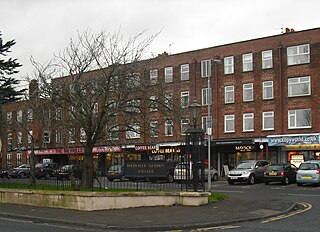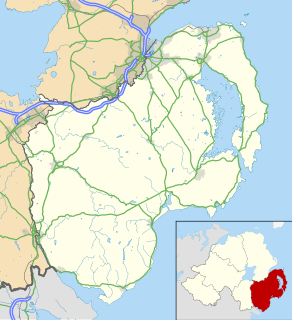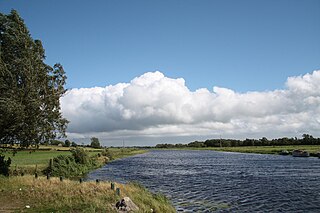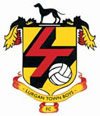Thomas Arlow McGrath (1896–1988) was a Northern Irish builder born in Lurgan, County Armagh, who founded Ulster Garden Villages in 1946 with the purpose of planning and building affordable, high quality post-war housing. [1]

Lurgan is a town in County Armagh, Northern Ireland. The town is near the southern shore of Lough Neagh and is in the north-eastern corner of County Armagh. Lurgan is about 18 miles (29 km) south-west of Belfast and is linked to the city by both the M1 motorway and the Belfast–Dublin railway line. It had a population of about 23,000 at the 2001 Census. It is within the Armagh, Banbridge and Craigavon district.

County Armagh is one of the traditional counties of Ireland and one of six counties that form Northern Ireland. Adjoined to the southern shore of Lough Neagh, the county covers an area of 1,326 km² and has a population of about 174,792. County Armagh is known as the "Orchard County" because of its many apple orchards. The county is part of the historic province of Ulster.

World War II, also known as the Second World War, was a global war that lasted from 1939 to 1945. The vast majority of the world's countries—including all the great powers—eventually formed two opposing military alliances: the Allies and the Axis. A state of total war emerged, directly involving more than 100 million people from over 30 countries. The major participants threw their entire economic, industrial, and scientific capabilities behind the war effort, blurring the distinction between civilian and military resources. World War II was the deadliest conflict in human history, marked by 50 to 85 million fatalities, most of whom were civilians in the Soviet Union and China. It included massacres, the genocide of the Holocaust, strategic bombing, premeditated death from starvation and disease, and the only use of nuclear weapons in war.
At least one of these projects, Merville Garden Village in County Antrim, still exists today. [2] He and his two eldest sons emigrated from Lurgan, County Armagh to Canada in 1952 and were later joined by the majority of their family, leaving behind only nieces and nephews.

Merville Garden Village is a housing estate located at Shore Road, Whitehouse, Newtownabbey, County Antrim, Northern Ireland created by structural and landscape architect Edward Prentice Mawson. It was completed in 1949.

County Antrim is one of six counties that form Northern Ireland. Adjoined to the north-east shore of Lough Neagh, the county covers an area of 3,046 square kilometres (1,176 sq mi) and has a population of about 618,000. County Antrim has a population density of 203 people per square kilometre or 526 people per square mile. It is also one of the thirty-two traditional counties of Ireland, as well as part of the historic province of Ulster.

Canada is a country in the northern part of North America. Its ten provinces and three territories extend from the Atlantic to the Pacific and northward into the Arctic Ocean, covering 9.98 million square kilometres, making it the world's second-largest country by total area. Canada's southern border with the United States is the world's longest bi-national land border. Its capital is Ottawa, and its three largest metropolitan areas are Toronto, Montreal, and Vancouver. As a whole, Canada is sparsely populated, the majority of its land area being dominated by forest and tundra. Consequently, its population is highly urbanized, with over 80 percent of its inhabitants concentrated in large and medium-sized cities, many near the southern border. Canada's climate varies widely across its vast area, ranging from arctic weather in the north, to hot summers in the southern regions, with four distinct seasons.
He died in Washington in 1988 at the age of 92. During World War I he utilized his carpentry skills by assisting with the repair of damaged aircraft. During World War II he owned and operated three ammunition factories in the Belfast area.

Carpentry is a skilled trade and a craft in which the primary work for performed is the cutting, shaping and installation of building materials during the construction of buildings, ships, timber bridges, concrete formwork, etc. Carpenters traditionally worked with natural wood and did the rougher work such as framing, but today many other materials are also used and sometimes the finer trades of cabinetmaking and furniture building are considered carpentry. In the United States, 98.5% of carpenters are male, and it was the fourth most male-dominated occupation in the country in 1999. In 2006 in the United States, there were about 1.5 million carpentry positions. Carpenters are usually the first tradesmen on a job and the last to leave. Carpenters normally framed post-and-beam buildings until the end of the 19th century; now this old fashioned carpentry is called timber framing. Carpenters learn this trade by being employed through an apprenticeship training—normally 4 years—and qualify by successfully completing that country's competence test in places such as the United Kingdom, the United States, Australia and South Africa. It is also common that the skill can be learned by gaining work experience other than a formal training program, which may be the case in many places.

Belfast is a port city in the United Kingdom and the capital city of Northern Ireland, on the banks of the River Lagan on the east coast of Ireland. It is the largest city in Northern Ireland and second largest on the island of Ireland. It had a population of 333,871 in 2015.











